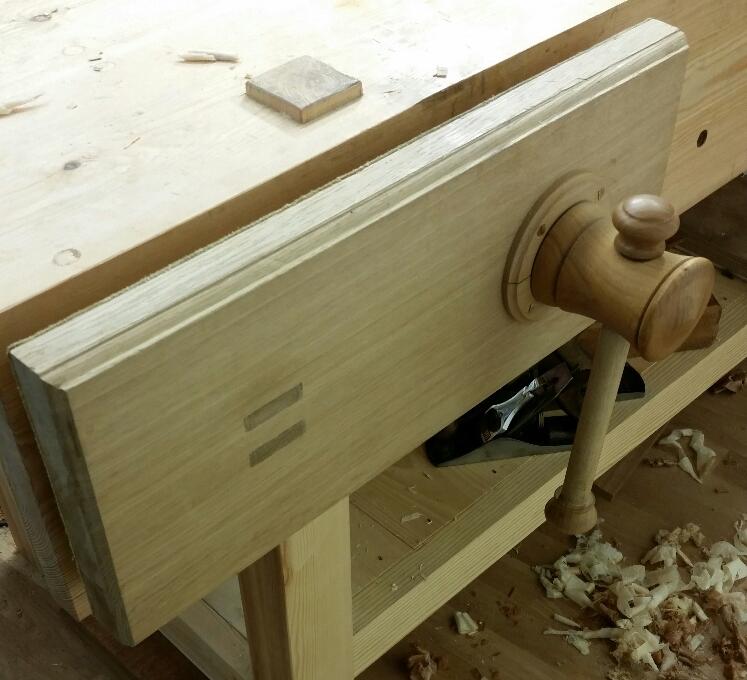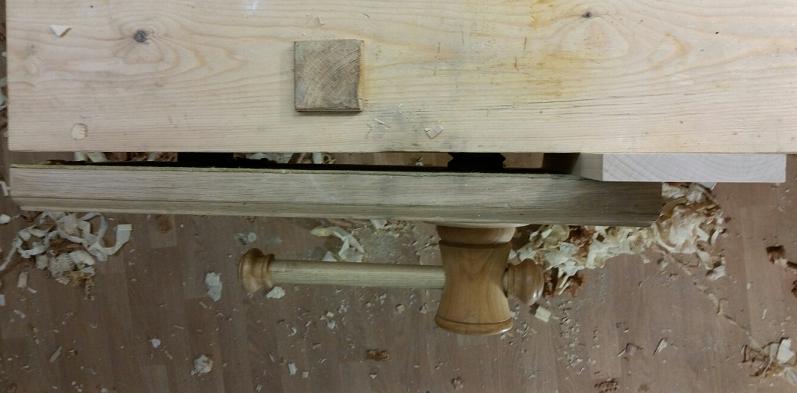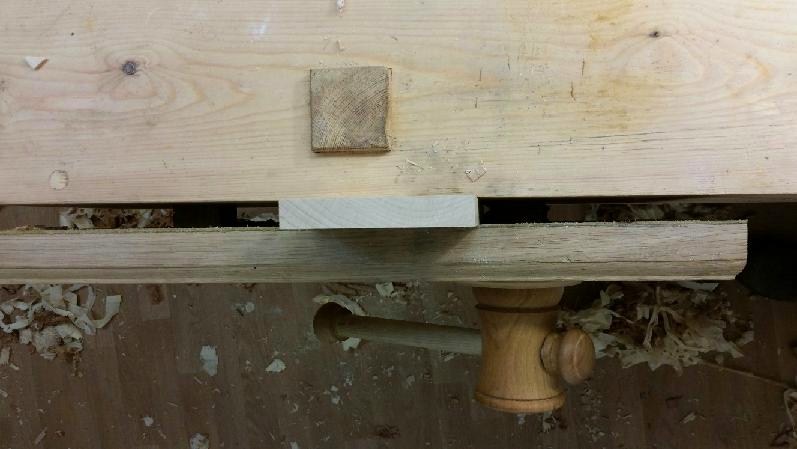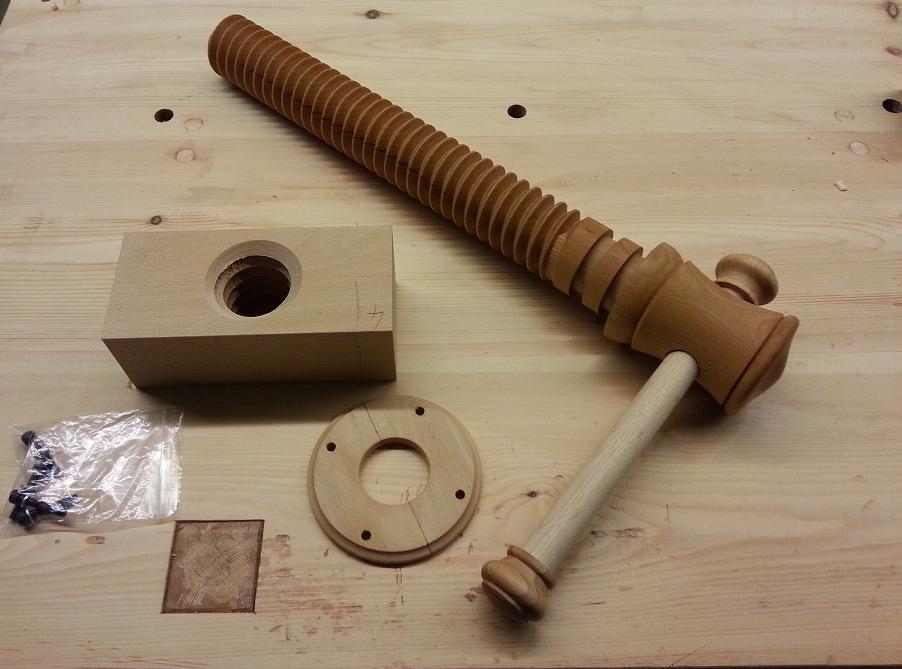We may receive a commission when you use our affiliate links. However, this does not impact our recommendations.
When I built my bench I wanted a cost effective vise that I could build myself. I had a choice between the popular leg vise or the less-liked face vise. One thing I was sure about was that I did not want a leg vise with a pin. I know there are some clever solutions to avoid the pin but they were not in the picture for me at the time of the build.
In our workshops we worked from between 1931-2006, there were two choices: a metal quick-release vise or a Wheelwrights vise. A wheelwrights vise is a leg vise that rises above the bench surface to allow the securing of the various components of a cart or carriage. I disliked it even as a child messing around with scraps of wood. Having to stoop down to move the pin was an interruption and I always found myself using the quick release.
In busy joiner’s workshops the metal quick release is a boon. It’s quick to use, very durable, consistent and grips very hard indeed. I was close to fitting one to my bench – but, like I said, I wanted to make something myself.
So what’s the big issue with the face vise? The only thing, and it’s a significant one, is racking. Take the image below as the primary example why the face-vise option is not so popular. With no pin in the runner, the face gets out of line and pressure is lost. But that’s not the end of the story.
The thing is, I don’t find I put the majority of my work there. I put my work between the runner and the screw (as you can see below) and the racking goes away. There is a clear 9-1/2″ of space between the screw and the runner allowing the majority of work pieces to be secured with ease. When I have things wider than this, I can clamp them to the apron with a couple of holdfasts or I can pop one end in the edge of the vise but add a scrap in the far end of the vise to prevent racking. With that in mind, I don’t have a loss of grip and I don’t suffer issues with racking unless I make them happen (such as for the photo above). There is a small amount of racking that occurs when work is longer and narrow, such as securing a door stile lengthwise, but so far what racking does occur has not changed my workflow.
So I was pleased to find the fear of workholding weakness in the design was a non-issue for me. When I first made the vise, I used a universal metal vice screw via a UK supplier under the York brand (Lee Valley has a similar offering). It worked great and I had no complaints with it. I made the handle from a piece of scrap oak and fixed a couple of beech cupboard knobs to the ends. I would have been happy to continue using that setup, but I had the chance to try something new to me via the English Woodworker. During the supplier’s recent move, there was surplus stock and there was this vise screw Richard Maguire deemed suitable for sale due to some defect I’m yet to find. Seriously – if this is a “seconds” then the ones for sale must be pretty special.
The wooden screw is a delight and the detailing is truly first rate. It’s been a pleasure using a set up that feels very authentic and sympathetic to how I like to work. The wooden screw advances faster than the metal screw but for shear value for money, the metal screw is hard to beat. If you find yourself building what has now become knows as a “Nicholson,” then you could do much worse than build a face vise. It’s easy to build, easy on the wallet and nowhere near as bad as you might think; I’d actually say it’s rather good.
— Graham Haydon
Here are some supplies and tools we find essential in our everyday work around the shop. We may receive a commission from sales referred by our links; however, we have carefully selected these products for their usefulness and quality.














The second vise I added to my bench was the face vise. The jaw measures 9″ tall by 27″ wide and 3″ thick. The 2-3/4″ diameter Hickory screw was made for me twenty years ago and does a marvelous job of cranking down on anything I feed it. For racking, I made up a shim set connected by an oversize bolt which keeps in place while the leaves drop in between the jaw and bench. Viola! No racking problem.
I’m not as experienced as you, so my opinion carries less weight, but I don’t care for vices in general. My current bench has a leg vice, which I’ve found to be the lesser of all vice evils, as it is fairly versatile and inexpensive. I’ve not been impressed with most vices I’ve come across, and most of them seem limited. The Moxon vice, was/is supposed to be something of a Godsend, which I at first liked, really is bordering on a specialty tool for sawing dovetails that needs to be “set-up” to use. The leg vice, if done correctly, does nearly as good a job and takes up far less space, as well as being more versatile.
I’ve found that holdfasts, clamps, and to a lesser extent wedges, have been my best option. It’s obvious that vices have their place and have been around forever. But sometimes I feel they aren’t worth the cost or hassle.
Graham, I think you missed the best solution out there which is indeed a pin and is used by the same Richard Maguire from whom you purchased your screw. It’s also easily done by anyone capable of building their own bench. I have about 30 years of using the same idea and I can say it indeed works great. It’s fairly cheap too. I paid nothing for mine as it was scavenged from throw away parts at work but anyone can buy the necessary rod and ball bearing bushing for ~$75 or maybe less if you look around the net. You get a leg vise and no bending over and no racking for cheap and easy.